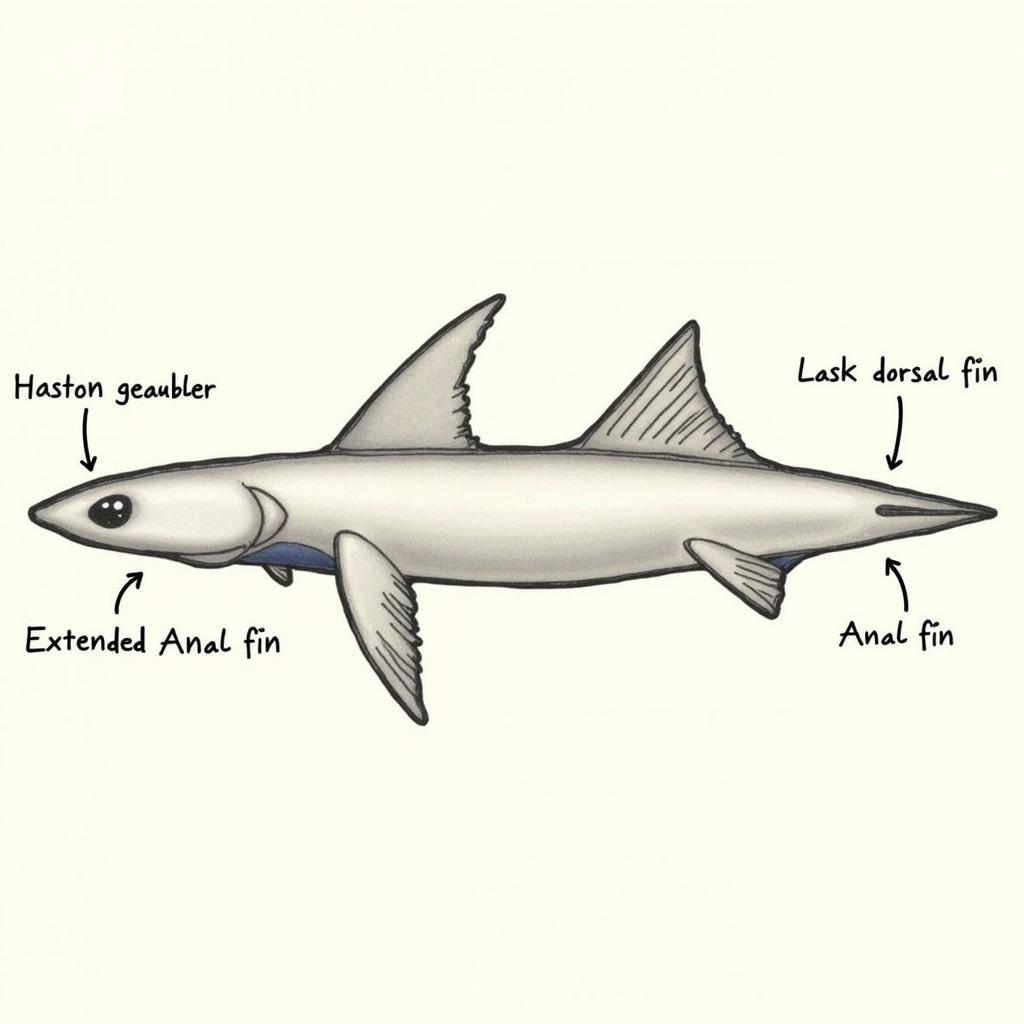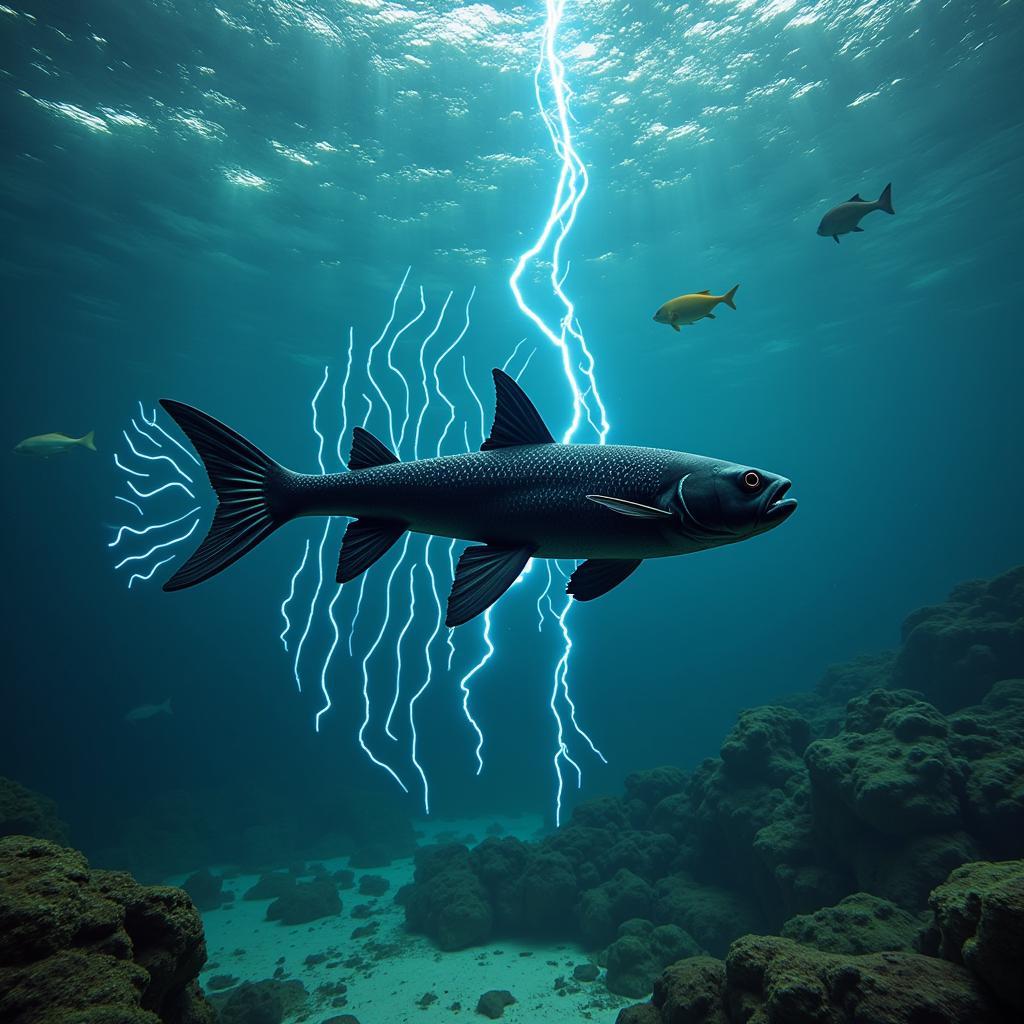The Enigmatic African Black Knife Fish: A Comprehensive Guide
The African Black Knife Fish, scientifically known as Apteronotus albifrons, is a fascinating freshwater species native to certain regions of Africa. These nocturnal fish are renowned for their unique appearance, intriguing behaviors, and captivating electric fields. Their sleek, black bodies, resembling a knife blade, make them a striking addition to any aquarium setting.
Unmasking the Black Ghost: Appearance and Anatomy
 African Black Knife Fish Anatomy
African Black Knife Fish Anatomy
The African Black Knife Fish boasts a distinctive appearance that sets it apart from other freshwater species. Its most prominent feature is its elongated, laterally compressed body that resembles the blade of a knife, hence its common name. They lack a dorsal fin, instead sporting an extended anal fin that runs along the ventral side of their body, almost connecting to their caudal fin. This anatomical feature allows for graceful, undulating movements through the water, mimicking the swaying motion of a leaf or plant matter, serving as camouflage in their natural habitat.
Their coloration is equally striking, with most specimens exhibiting a velvety black hue that can appear almost iridescent under certain lighting conditions. This black backdrop is often accented by a contrasting white or yellowish band running along the base of their anal fin, further enhancing their visual appeal.
The Silent Language of Electricity: Electroreception and Communication
 African Black Knife Fish Electroreception
African Black Knife Fish Electroreception
One of the most captivating aspects of the African Black Knife Fish is its ability to generate and perceive weak electric fields. This remarkable adaptation, known as electroreception, plays a crucial role in their navigation, foraging, and communication. Located near their tail, a specialized organ known as the electric organ emits a continuous electric field that envelops the fish. Any disturbances or alterations in this electric field, caused by objects or other fish, are detected by electroreceptors distributed across the fish’s body.
This remarkable sensory system allows African Black Knife Fish to navigate murky waters with astonishing precision, even in the absence of light. They can detect prey, identify obstacles, and even distinguish between different species based on the unique electrical signatures they emit. Moreover, they use subtle modulations in their electric organ discharges to communicate with each other, conveying messages related to courtship, territoriality, and even aggression.
Navigating the Nocturnal Realm: Habitat and Lifestyle
In their natural habitat, African Black Knife Fish are predominantly found in slow-moving, often turbid waters of rivers and streams across parts of Africa. They are primarily nocturnal creatures, seeking refuge during daylight hours among dense vegetation, submerged roots, or rock crevices. This nocturnal lifestyle is closely intertwined with their electroreceptive abilities, allowing them to thrive in environments where vision is limited.
As opportunistic omnivores, their diet consists of a variety of small invertebrates, insect larvae, and crustaceans that inhabit the bottom substrate. Their electric fields not only aid in detecting these prey items but also in stunning them before capture. Their elongated snouts are perfectly adapted for foraging in tight spaces, probing the substrate for hidden food sources.
Coexisting with the African Black Knife Fish: Tank Mates and Care
For aquarium enthusiasts looking to house these fascinating creatures, it is crucial to replicate their natural habitat as closely as possible. A spacious tank with a soft, sandy substrate and plenty of hiding spaces such as caves, rocks, and dense vegetation is essential for their well-being. They prefer dimly lit environments and are sensitive to sudden changes in water parameters.
While generally peaceful, their electroreceptive nature makes them unsuitable tank mates for certain species. Avoid housing them with aggressive or fin-nipping tank mates. Ideal companions include other peaceful, similarly sized fish like certain species of tetras or even some types of African cichlids. You can learn more about the compatibility of African Brown Knife Fish with cichlids in our dedicated article: african brown knife fish with cichlids.
Ensuring a Thriving Aquatic Companion
Understanding the dietary needs of the African Black Knife Fish is crucial for their health and longevity in captivity. As they are primarily carnivorous in the wild, their diet should consist of high-quality protein sources. Live or frozen foods such as bloodworms, brine shrimp, and blackworms are excellent options, mimicking their natural prey.
It’s important to note that these fish can be picky eaters, especially when first introduced to a new environment. You can find more information about their feeding habits in our article: african knife fish eating. Regular water changes and maintenance are crucial to maintaining optimal water quality and preventing the buildup of harmful toxins.
Conclusion: The Allure of the Electric Enigma
The African Black Knife Fish stands as a testament to the incredible diversity and adaptation found within the aquatic realm. Their unique combination of striking appearance, intriguing behaviors, and captivating electric fields makes them a captivating subject of study and a rewarding addition to any aquarium. By understanding their specific needs and replicating their natural environment as closely as possible, we can provide these fascinating creatures with the care they need to thrive in captivity. For those intrigued by the world of electric fish, exploring the world of the african ghost knife fish can offer further insights into this fascinating adaptation.



